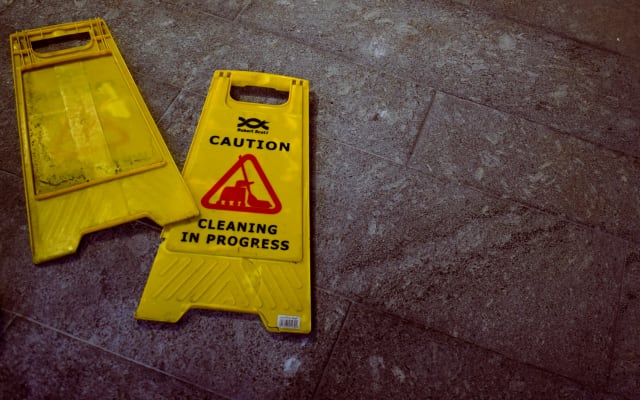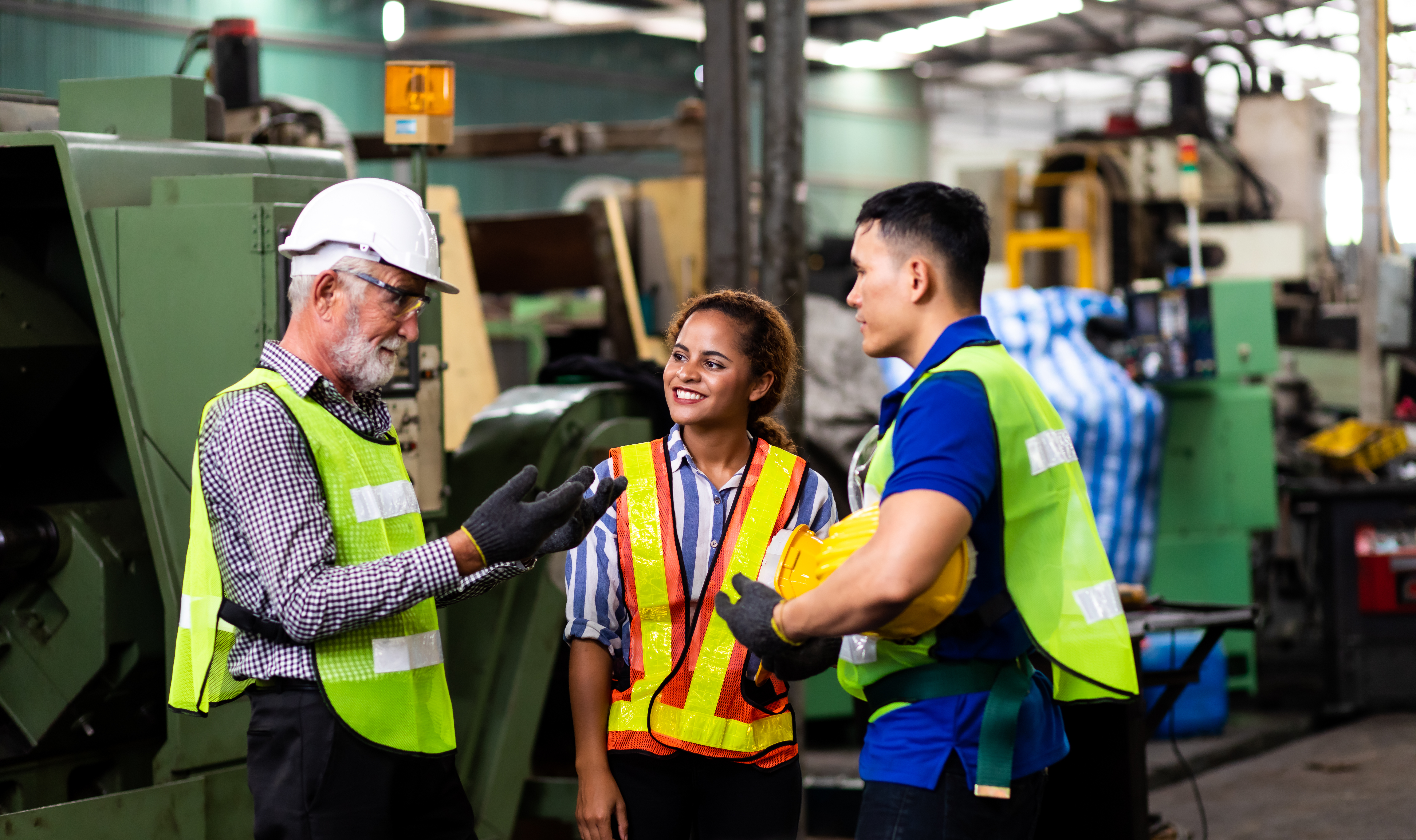Slips, Trips and Falls in the Workplace

In the world of health and safety, many issues are all too easy to overlook. A puddle of water in the corridor? How about an extension lead stretching across the length of the office? Someone will clean it up and tidy, won’t they? And besides, it's not like you can really hurt yourself tripping on a cable, right?
Of the 604,000 non-fatal injuries sustained by workers in 2023/24, 31% were slips, trips or falls. That’s almost 200,000 injuries, many of which led to 7 days or more of workplace absence (1). Overlooking even the smallest hazards can result in a risk of serious injury, and that’s just as true for hazards which could cause slips, trips and falls in the workplace. In this post, we’ll discuss the dangers of slips and trips in the workplace, their common causes, and how you can reduce the risk of them through health and safety training courses.
Slips, trips and falls in the UK
In 2023/24, slips, trips and falls were the most common cause of workplace injury, accounting for over 30% of all non-fatal injuries. Including time lost due to absences, sick pay, and all other costs, these injuries cost UK organisations over £500 million (2), despite there being less slips, trips and falls than previous years.
In other words, big statistics aside, slips, trips and falls in the workplace need to be taken seriously. Otherwise, members of your team could be injured, and your organisation could suffer financial penalties and reputational damage.
What is a slip, trip or fall
Knowing how to deal with hazard effectively starts with being able to identify the hazard. While we could all identify a slip, trip or fall, it’s important to know their exact definitions.
Slips are where an individual loses their grip on the floor and fall overs
Trips are when a hazard or uneven surface causes someone to lose their footing
Falls are any form of accident where an individual drops to the ground, so slips and trips are considered falls. However, there are also falls from height. These are similar but involve a fall from one level to a lower level, such as from a ladder or scaffolding.
Common causes of slips, trips and falls
So, we know what slips, trips and falls are. The next step in reducing the risk of them comes with knowing their causes. HSE guidelines set out 3 main causes, any of which can lead to slips and trips.
Housekeeping
The build-up of obstacles and hazards in the workplace is one of the major causes of slips and trips. This stems from poor housekeeping and cleaning practices, leaving items exposed in walkways. Whoever spots an issue should deal with it as soon as they see it to prevent injuries occurring, and your site should be cleaned thoroughly and regularly, to account for anything missed.
Walkways
As well as being clear of obstacles, walkways should be in areas where they are needed. That may sound silly, but it’s important that people on your site can walk safely, no matter what their destination. Having difficult or winding paths to get off site can be a serious danger during an emergency, as people may not be able to evacuate quickly enough.
Design and Maintenance
While cleaning can help keep clutter away, wear and tear will always occur overtime. Conducting regular checks, such as in site audits or risk assessments, can help keep areas safe and walkways without cracks or snags.
It’s also important to consider hazards during the design phase. Are areas wide enough to accommodate people? How about in emergencies? Is their provision for those with mobility difficulties such as railing? Considering all these questions, especially around stairs, ramps and other areas where elevation changes, is key to creating a safe working environment.

How to prevent workplace slips, trips and falls
Suitable footwear
Slips and trips often occur because we lose our grip on the floor, and this is all the easier when you’re wearing improper footwear. Requiring staff to wear sensible shoes with a good grip, especially if they’re somewhere where spills have occurred in the past, is an effective way to prevent slips and trips.
Workplace maintenance
Wear and tear are an inevitability, and you can only do so much to prevent damage over time to your workplace and its equipment. By regularly checking equipment and welfare facilities, you can get ahead of breakages and get repairs made without major disruptions to your workplace. However, even if damage occurs to flooring, equipment, whatever it may be, it should be fixed in good time. By maintaining your workplace and keeping it safe, the risk of slips, trips and falls is reduced.
Regular cleaning
The bane of a relaxing Sunday afternoon, cleaning is as important in the workplace as it is at home. By cleaning regularly, you can keep on top of obstacles and spillages that could cause slips and trips if left unchecked.
Risk assessments
The one thing all the causes of slips, trips and falls have in common, is that they’re all hazards, and the most effective way to identify and deal with hazards is with a risk assessment. They’re three-step processes, usually conducted by a health and safety advisor or manager with the proper training. Performing them regularly is a requirement of health and safety law too, so it's key that someone in your workplace knows how to carry one out effectively.
The 3 steps of a risk assessment are:
Identifying hazards
Assessing the risk the hazards pose
Putting safety measures in place to reduce risk
By carrying out risk assessments regularly and documenting them, you can identify hazards that could cause slips, trips and falls. By putting in place effective safety measures and health and safety systems too, you can create a safer workplace environment.
Training
Slips, trips and falls are often caused by hazards which are easily identifiable, such as leaks, spills or faulty ladders. By providing members of your organisation with health and safety training, you can give them the skills to identify hazards and work safely, avoiding slips, trips and falls.
IOSH Working Safely is the ideal course for most workers without management or leadership responsibilities. Across 8 hours of e-Learning or one day in the classroom, it teaches delegates about workplace risk and how to identify hazards, giving them the tools to understand and report them to managers or supervisors.
For those at risk of falls from height, such as construction workers or warehouse staff, we also offer our Working at Height training course. In just 90 minutes of e-Learning the course runs through a step-by-step guide for working at height, including the legal requirements and preventative measures.
Supervision
Ever had tunnel vision while you work? So focused that you missed a call or didn’t hear someone calling you from across the room? When a worker is concentrating, they can miss hazards or make small mistakes, such as not checking their ladder or carrying heavy equipment through a corridor with a spillage. In these situations, having a supervisor on hand who can spot hazards and ensure work is being carried out safely is critical.
Providing supervisors with effective health and safety training is straightforward, as the IOSH Managing Safely training course covers everything they need to know about occupational safety. This includes how to conduct a risk assessment, the legal requirements of health and safety, and how to look after the safety of other members of staff.
Slips, trips and falls are ultimately accidents that can be easily avoided. By engaging in proper cleaning and maintenance, as well as providing health and safety training, organisations can reduce the risk of incidents. Even with these measures in place though, it’s important for all employees to stay vigilant of hazards, as even a single mislaid cable can lead to injury.
Want to know how your organisation can keep its members safe? Or want to start your journey in the health and safety industry? Contact a member of our team today.
References:
1.https://www.hse.gov.uk/statistics/causinj/index.htm
2. https://www.hse.gov.uk/plastics/slips-trips.htm#:~:text=Slipping%20and%20tripping%20in%20the,lost%20production%20and%20other%20costs.